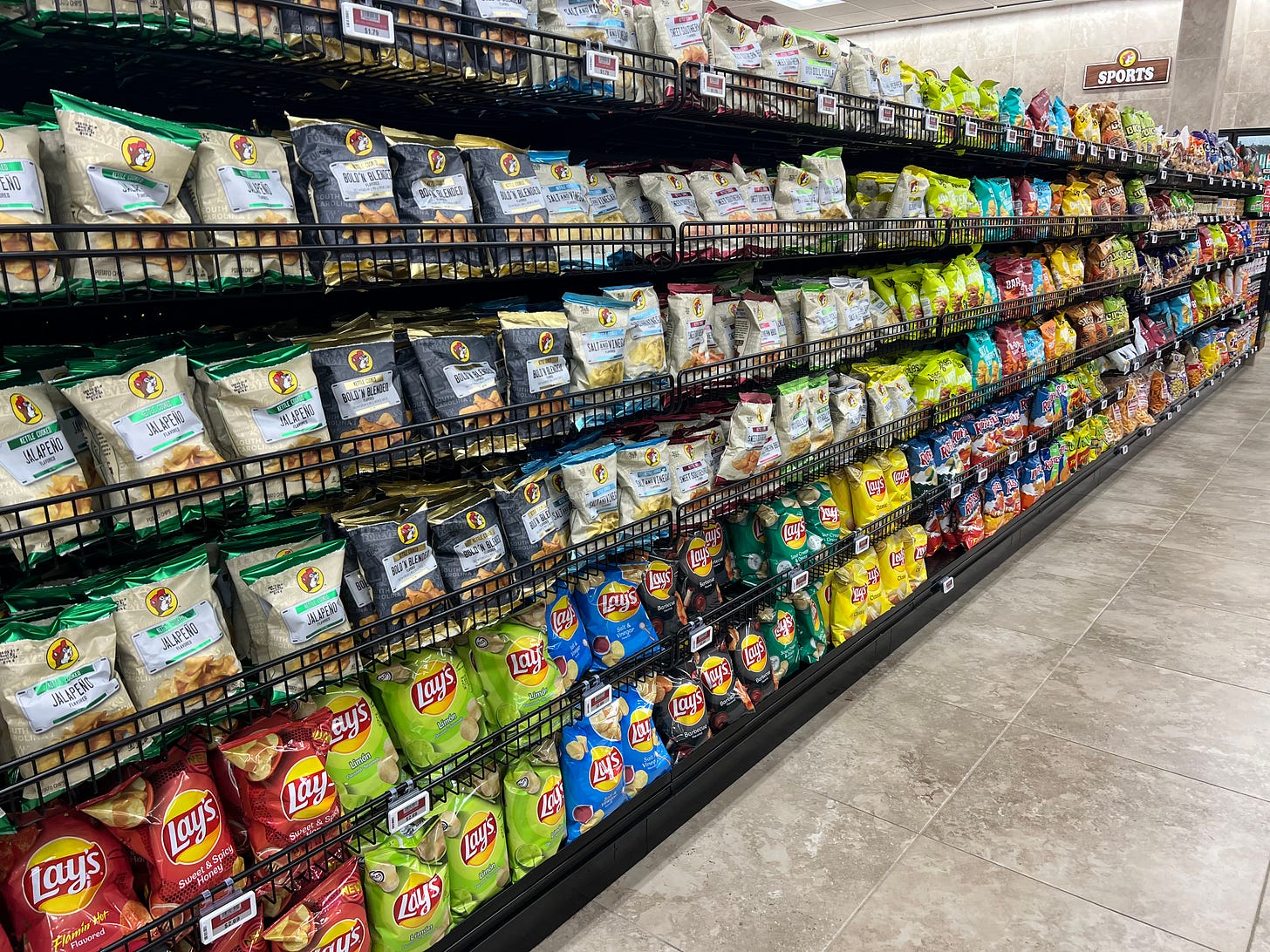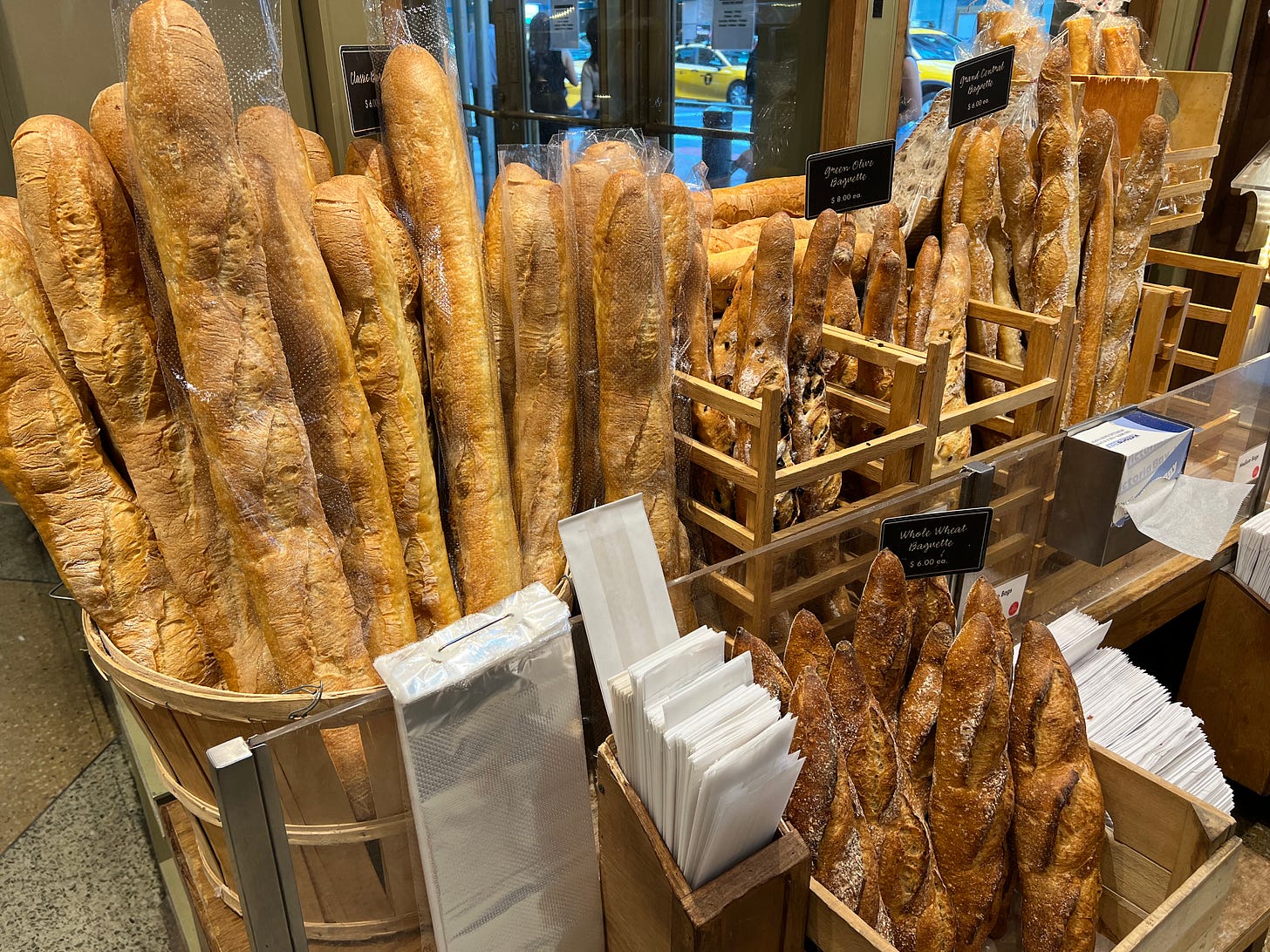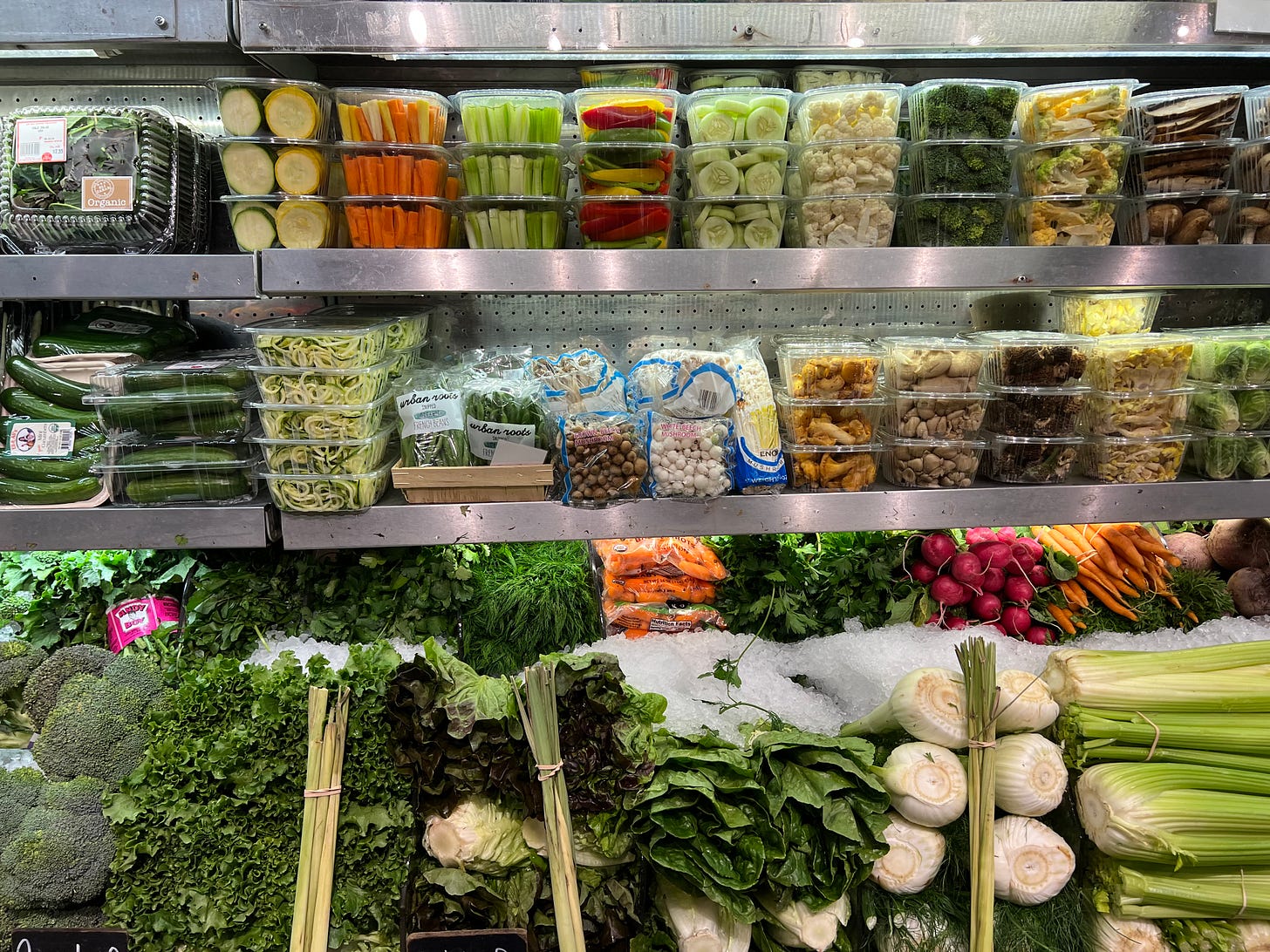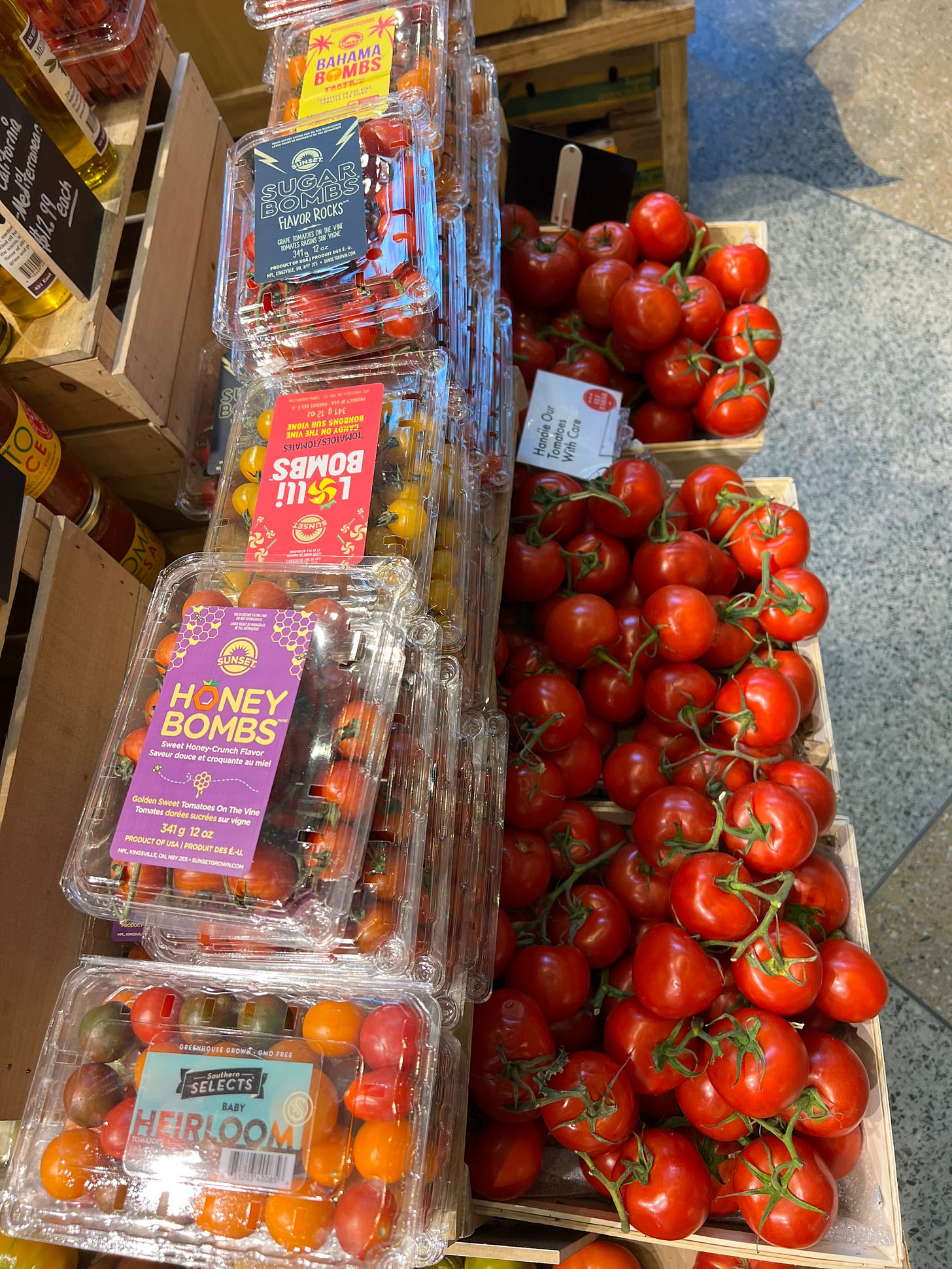Discontents: 1. What Is Specialty Food? 2. Grand Central’s Marketplace. 3. Canaan Fair Trade 4. Ziba Foods. 5. Tunes
1. Almost everyone loves specialty foods.
We all look forward to them. Olives, charcuterie, fresh picked greens. Sprouted almonds, wheels of parmigiana, fresh ground fair trade coffee, smoked wild salmon, anything with truffles. Specialty foods sustain our body and soul while enabling to us to find joy and pleasure in eating.
So, why isn’t all food specialty? Why is some food special? Is some food not? This distinction hints at the existence of an opposite, a contradiction to specialty food. Specialty foods, while “special”, still exist and depend on an industrial food system. The contradiction to specialty food, indeed that which is necessary to truly define it, is commodity food.
Commodity food is ubiquitous, anonymous, mass marketed.
It is the foundation for our food supply, the bulwark against famine. It is everywhere yet mostly undefined, uncertified, unlabeled, taken for granted. It is the bottom 9/10th of the food pyramid.
Specialty food is particular, has an identity, an origin story.
Specialty food has attributes, descriptors, explanations and loads of marketing copy. It has to set itself apart through labels, certifications, validations. Specialty food is free of poisons and toxins, or is at least trying really hard to be. It pays farmers fairly. It can be pricey, but the cost, we hope, is worth it.
Commodity food is Atlas, shouldering the food system, shrugging at our petty bourgeois desires for taste, experience, newness and joy from food.
Commodity food runs the global economy.
It is the four grain traders that control the world’s grain supply. Deregulated speculation, gambling on the prices of these grains. A handful of conglomerates that control 70% of cereals, 80% of chocolates, 90% of soft drinks. Tomatoes from Immokalee. Chiquita bananas. Concentrated animal feedlots. Meat cartels. Walmart. That box of packaged food castoffs you get from the food bank. What you can afford until SNAP runs out halfway through the month. Government cheese. Subsidized corn and soy monocultures for ethanol, animal feed, corn syrup, distillers grain. Grown on land stolen from native peoples. Traded via federally negotiated multilateral agreements, enforced by 900+ military bases and a stockpile of ICBMs. Regimented, plantation-based economic patterns, now in processing plants and fulfillment centers. Forced labor, child labor, your underpaid labor fueling the machine like fracked gas, diesel and gasoline. Railroads, highways and country roads in grid patterns, built to enclose and extract value from the countryside to urban centers, factories and ports, where pork, milk powder, feed corn and wheat are shipped overseas. Iowa and coastal North Carolina as pork colonies for the burgeoning Chinese middle class. Corporatization. Monocultures, homogenization, genetic modification, hybridization, built for scale and yield. Cold and gray, the color of cement killing floors and cumulonimbus clouds thundering over those stolen prairies.
Commodity food feeds the world, gazing down at all of us needing our calories, protein, vitamins and nutrient supplements to work, sleep and reproduce like good little consumers. There is no past with the commodity, just this present, and the futures that the mercantile exchanges gamble on. Commodity food scoffs at its externalized costs. These are the sacrifices we all must make for cheapness, bigness, convenience, abundance, sustenance.
Just don’t ask about the profits, that is commodity business, not yours.
Specialty food asks questions, does the math, considers purpose, intention and effects. Specialty food champions diversity, inclusion, heritage and innovation, tradition and moving forward. Labor matters, nature matters. Specialty food wears its heart on its sleeve. Specialty food tries and fails and fails again, and just keeps at it. Specialty food is always optimistic, naïve, yet knowing a little too much. Specialty food is delicious. We always look forward to specialty foods.
But commodity and specialty are intrinsically bound to each other. They need each other. Those happy cows lactating the world’s greatest cheeses fattened on Cargill-traded grains. The award winning sauces made with tomatoes from Immokalee, mined salt, spices from India and Vietnam. The plant-based sausages extruded from monocultured soy and wheat proteins. The crisp lager from malted grains sprayed with glyphosate, grown amongst GMO corn and soy rotations. The oil palms where orangutans used to shelter. Every pound of filet mignon that means 10 pounds of 80/20 ground chuck and 1800 gallons of water. Shipped on container ships, stacked on wooden pallets, shrink wrapped in plastic from the Gulf Coast, boxed in corrugated cardboard from Dayton, Ohio, delivered to you by gig workers.
Commodity foods are anonymous but not shy. They evolve, change, integrate. They ingratiate with organic, regenerative, animal welfare, fair labor, holistic supply chains. Doing just enough to polish off the blood and grit while always bending, conniving, convincing the world to compromise to their whims. Specialty food is an incubation, an ambition, a handhold for the next conquest. Enabling the Titan Cronos to escape Tartarus, Sauron finding the One Ring. The commodity dies without change. It needs the specialty.
There is no specialty without the underlying commodity. There is no commodity without its bleeding edge specialty.
A wicked dialectic, a culinary yin and yang. So, again, why isn’t all food specialty?
2. Grand Central’s Marketplace.
Grand Central Station in New York is among the greatest architectural wonders I have seen in my life. The soaring ceilings, the cavernous arches, the polished stairwells, the almost windswept vibe of the massive indoor space. Filled with thousands of travelers daily, zooming across from train to bus to subway line. Such a cool spot for the most boring and redundant of chores. Commuting. Ugh. Commuting. But this train station’s intersection of the grandiose and the workaday means that the food too must be attention grabbing.
Like all decent travel stations, Grand Central has food halls. Not as expansive as neighboring Moynihan Trail Hall or Penn Station, but more than adequate. Not mid. Grand Central also has a marketplace, a little public market in the spirit of Essex or Chelsea, but in miniature.
I stumbled upon the marketplace at Grand Central a few years back after walking from a meeting on Park Ave in the 50’s. I liked to walk a block over and go down Lexington past the comic book store towards Curry Hill, the blocks in the 20’s where all the cheap South Asian take out restaurants are. I got waylaid heading south one time when I noticed a little public market around 43rd.
I love public, open air markets, even if they are indoors.
I really prefer then to my home turf of grocery stores. Grocery stores can be both claustrophobic and maddeningly enormous, but public markets can hit that sweet spot of cozy and spacious. They are essential. This one at Grand Central had a vibe that was just right.
I will get this next point out of the way because this is New York City we are talking about. Everything inside was expensive. Zabar’s, Murray’s, the pastries, the bulk spice and tea sellers. Really freaking expensive. Traveler-centric retailers are always pricier. Their business models are high overhead, high turn, high margins. This one erred on the side of airport-level price gouging.
But instead of an airport Hudson News’ mind numbing samey-sameness or Cibo’s chaotic garage sale aesthetics, the Grand Central marketplace was as close to retail perfection as I have seen in the city. The vendors inside were all executing like they were waiting for a C-Suite holiday-season walk thru (If You Know You Know). The staff were friendly, helpful, tired-eyed, but engaged like they didn’t mind the rush of customers escaping downwind from a hundred arriving and departing trains.
And the food? Heaven.
Racks of fresh baked breads, baguettes, bagels, kaiser rolls, brioche, and even gluten-free loaves. Stacks of stonefruit, ripe and in season, 3 varieties of apricots, several types each of plums, peaches, nectarines, including conventional and organic. Frog Hollow peaches, in midtown Manhattan of all places. All hand stacked red, pink, yellow and violet in green paperboard cartons with handwritten liquid chalk signs.
A tightly packed wet rack, loaded with ice, cooling down the greens, celery, broccolini, carrots and radishes on a heat-domed spring evening. Dozens of hand cut and pre-packed vegetables ready for snacking or easy usage in the kitchen.
Ripe tomatoes in too-cute-for-their-own-good branded cartons, with each variety of cherry or plum tomato claiming to be sweeter, pluckier and snackier than the others, honey, lollipop, sugar, bomb, bomb, bombs, almost pornographic.
They’re just tomatoes for fuck’s sake.
Lemon Perfect sugar free hydration drinks, Red Jacket apple and fruit juices, forever my favorites, and quaint Ronnybrook drinkeable yogurts topping off a beverage set.
Glass coolers of cakes, pies, tarts, cheesecakes, cookies, giving me a diabetic coma contact high. A chocolatier kiosk with packed trays of cookies, brownies, squared off hunks of bulk cocoa and white chocolate, truly gorgeous confections. Honestly, the most carefully merchandised loose/bulk spices and tea assortment my jaded American eyes had ever seen (as I have never been to a real Souk). Everything was so delicately displayed behind a glass counter, I tried not to breathe too hard lest I displace the immaculate rainbow piles of oolong, mate, za’atar, curry, cumin, chili.
At the meat case, a basket of “homestyle” pasta sauce. As if I grew up with a loving Italian grandma who spent all day over the stove simmering imported plum tomatoes for my spaghetti dinner.
Pre-packed olives and artichokes, coasting off the ambience at probably the most reasonable prices in the place. Vietnamese rice-paper wrapped lobster rolls, fresh fried eggrolls and dumplings by the pound.
A packaged food section on metro shelving, like an old school, pre-acquisition Balducci’s in miniature, with precious jars of French mustards, Fishwife canned salmons, Caribbean hot sauces, Maine Coast crackers and a few dozen bottles and boxes of stuff you have never heard of or seen before, never tasted, were not interested in until you realized you have a basket full of them for $75. The bastards.
This is specialty food. Maddening. Utterly essential.
An oasis in the city, an open air market in the busiest commuter terminal. Filled with fresh, delicious, gorgeous food that anyone should have. SNAP should pay for this if there were justice in the world. But so overpriced, ostentatious, over-precious, and a little silly. But sincere, authentic, fun and just serious enough to make sure you get in, get what you need for more than you can afford, and then send you on your way.
3. Palestinian Fair Trade
The Checkout Podcast Episode #184, with Nasser Abufarha.
The Checkout spoke with award-winning olive oil producer and fair trader Nasser Abufarha about war, Regenerative Organic agriculture and Levantine foodways.
“Canaan works with over 1,000 artisan family farms spanned across 43 different villages. We are engaged year-round with these communities, committed to long term partnerships with fair trade principles that ensure transparency, full direct payment, fair prices and purchase guarantee.”
Palestine Specialty Foods:
We were heartened to see a small pavilion of Palestinian producers at the 2024 Specialty Food Show, among the troves of international products from Greece, Turkey, Italy, Morocco, Ecuador, Mexico, China and kosher brands like Manischewitz, newly acquired by Kayco. On display by Palestinian traders were dates, halva, olive oils, tahini, and other high quality products. At least one of the producers, Orib Ayesh & Sons, was an Israeli-Palestinian joint venture. This is Tikkun Olam.
4. Ziba Foods
I am obsessed with these nuts and trail mixes from Ziba Foods. Ziba Foods is bringing high quality, fairly traded, Afghani-grown foods to the masses with these beautifully packaged snacks. Afghanistan has had a hell of a time the last 45 years or so. Soviet invasion, U.S. funded counterinsurgency, the Taliban, the Taliban again after 20 years of the U.S. invading, occupying and bombing this mountainous, breathtakingly beautiful country in Central Asia (not the Middle East!). Afghanistan had previously been well known for its agricultural output and mastery of farming. Ziba Foods is reminding the world that Afghanistan produces some of the world’s most delicious foods, regardless of the current political turmoil. My favorites are the baby pistachios and the trail pairing, a mix of mildly sweet dried mulberries and crunchy, salty apricot kernels (kind of like tiny almonds). A little pricey but sooo good.
5. Tunes.
Tariq Trotter is the world’s greatest living MC. There, I said it. Also known as Black Thought of The Roots, he did this epic freestyle on Hot 97 a few years back.
peace.















Fucking awesome Errol. (If you know, you know 😌). More dispatches please.